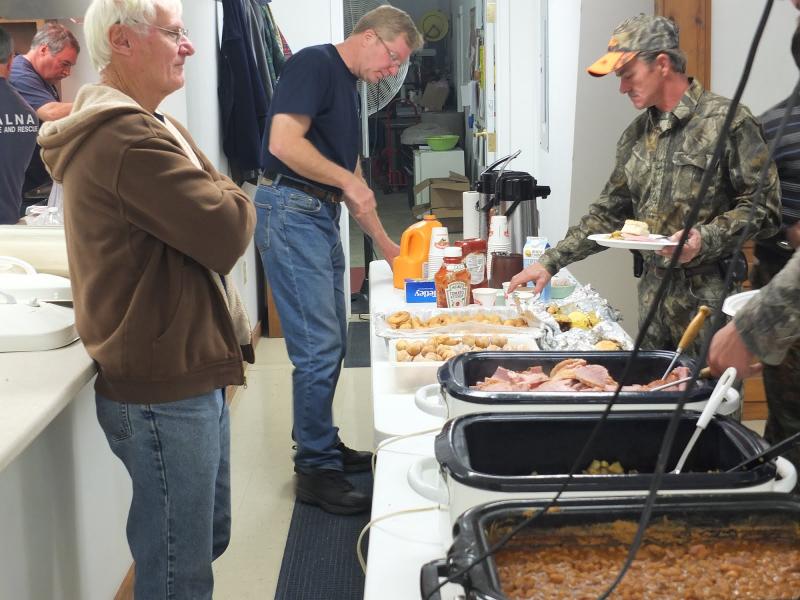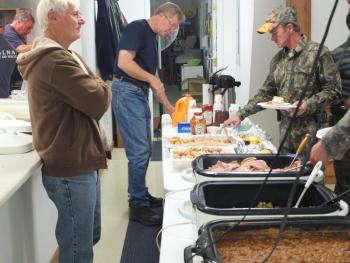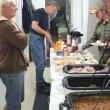Deer hunting season opens
Deer hunters took to the woods early Saturday morning, Oct. 27, in clear, mild weather for the first day of firearms deer hunting season. There are mixed reviews as to number of deer in the Midcoast region, but hunters interviewed at the annual Hunters' Breakfast at the Alna Fire Station said they enjoy getting out in the woods, regardless of what they find.
“It's something I look forward to every fall,” Wiscasset resident Dave Sawyer said. He started hunting with his father and uncle when he was very young and has now been practicing the ritual for 48 years.
Sawyer said he has not seen many deer in the past couple of years, but believes there may be more out there in this part of Maine.
Like some hunters, Sawyer guessed he has a 50 percent chance of bagging a deer. Even if the deer population isn't what people expect, he said it is still a good experience: rising in the dark of early morning, treading softly out into the woods and finding a place to witness the stirring of life as daybreak approaches. He said it's exciting when he finally catches a glimpse of a deer, but hunts with practiced caution.
The firearms portion of deer season runs from October 27 until November 24. The season overall runs until December 8.
Sawyer follows a certain ethic in hunting. He has taken the hunter safety course four times and is careful about what he shoots. For example, he said he would not shoot a doe if it is clear to him her fawns are not fully grown. To shoot a doe with a fawn that has not reached maturity enough to care for itself is like shooting two deer, he said.
The hunters in Alna seemed thrilled about finally getting out into the woods, regardless of whether or not they saw a deer. Though it was just before 5:30 a.m., friends gathered around tables bantered with one another and grinned over cups of steaming coffee.
Michelle Bryer, who came to the breakfast early, was eager to get outside. She gave herself the same chance of finding a deer as Sawyer. She said she has seen deer off the side of the road as she traveled by car, “but that doesn't mean there aren’t more in the woods.”
According to Mike Witte, an Advisory Council member for Maine's Department of Inland Fisheries and Wildlife (IF&W), deer populations in the southern tier of the state are “doing very well.” Witte is the Knox, Lincoln and Waldo counties’ representative on the council.
He added that making an accurate determination is difficult. Deer in the Midcoast and southern parts of the state are protected to some extent by human activity. However, deer herds move in reaction to any development activities, such as cutting several acres of trees, so keeping track of them is a challenge. A healthy deer herd in the southern tier may also be attributed to last year's mild winter.
Two dangers threatening deer herds each winter are ice crusts on top of snow and coyote attacks. Deer, with large upper torsos and long legs, struggle through heavy snow and when ice forms on top they are at a significant disadvantage when coyotes prey on them.
Witte said the northern deer herd seems to be doing better. He said the fawn counts are up, which shows reproduction is good. And deer in the north are not as stressed out as in past winters, “but we are right on the edge.” The health of a deer herd is weather-dependent and no one knows for sure how they will fare this winter. “People don't seem to understand that a successful management plan takes five to seven years; it doesn't just happen overnight,” Witte said.
Witte said Maine has one of the best hunter education programs in the nation. He estimates that 200-300 people have taken courses this year. The IF&W has information online for archery, crossbow and firearms hunter education, as well as a handy downloadable “Lost Hunter's Guide.”
Event Date
Address
United States

























